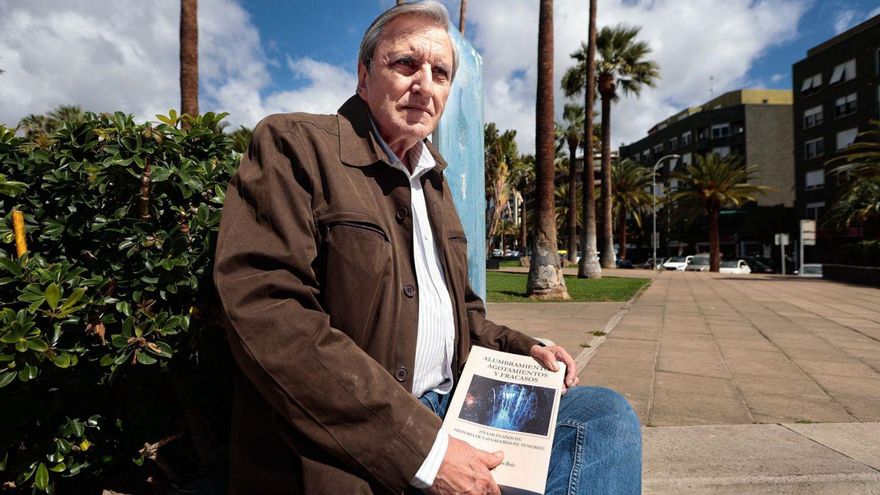
How do you assess the declaration of a drought emergency on the island? Could it potentially affect human consumption or lead to restrictions like in Fasnia, Arico and, a few days ago, Icod?
Predictably, Vilaflor will also be affected. In the highlands of the island, in the south, the galleries are directly connected to the surface through fractures. When it rains, they collect water and retain it for a while. If it doesn’t rain, they remain empty. Measures will indeed need to be taken. I am very concerned about Vilaflor, as I know it very well, and I know that the water they use for supply and distribution comes mainly from galleries that are directly fed by rainfall.
Summarise the 175 years of groundwater on the island outlined in your suggestively named book: Births, depletions and failures.
First and foremost, I would like to thank my publishers, the Insular Water Council of Tenerife, the College of Civil Engineers, and the Insular Water Chamber. It has been 175 years because it is 2020, and the first gallery dates back to 1845 due to a circumstantial issue. The lack of water for the Santa Cruz laundry project led to the search for water by any means necessary. The City Council aimed to increase the flow of the Aguirre springs (Anaga) using a bore brought from England to drill artesian wells, but the initial attempts were unsuccessful. With prior municipal permission, some individuals handed it over to a French subject who knew how to use it, resulting in the first horizontal subsurface drilling on Tenerife in search of water: the gallery known as La Cueva del Francés. It only produced around 10 to 20 barrels per hour, but it marked the starting point for more drillings and the establishment of companies or societies for the research, exploitation, canalisation, and use of groundwater resources. By 1915, there were already about a hundred such societies and 300 galleries, mostly small ones.
Wouldn’t understanding Tenerife’s history be incomplete without knowing about the water cycle and its management?
Clearly, it wouldn’t. I will refer to my dear friend Adolfo Hoyos-Limón, who has since passed away. He was my boss – the director general of Water – and a role model. He used to summarise it with a question and its answer: What would Tenerife be without the galleries? Thanks to them, we have water to drink. It is important to appreciate what the extraction and use of underground resources have meant for the island. Adolfo Hoyos invites us to admire the water extraction and utilisation works that have allowed Tenerife to thrive since the late 19th century, culminating in something worthy of admiration for its global dimensions and what it reveals about the initiative, perseverance, and sacrifice of its promoters. The water management efforts in Tenerife have worked, and not as poorly as some may think, for over a century.
In 1913, a key event took place in Anaga, followed by another in 1925 in Arafo. Can you detail both?
In 1913, the sudden appearance of a majestic stream of water while drilling a tunnel in Anaga to divert water from the Roque Negro springs on the north slope to Catalanes on the south slope revealed the existence of deeper and more abundant waters than those provided by the natural springs. These were contained in the previously unknown basal aquifer. At 600 meters from the mouth, an impressive flow emerged, a continuous stream of water. Whereas the average output was around 200 barrels per hour, between 1,500 and 2,000 barrels were brought to light. Unfortunately, an avalanche caused the death of five workers, but in popular belief, it remained that Anaga had a never-ending river of water. From 1915 onwards, new galleries were no longer located around natural springs, as the goal was to tap into deeper waters. Their paths extended as needed to connect with the aforementioned basal aquifer, giving rise to the so-called conventional galleries. In 1925, the Los Huecos gallery in Arafo made contact with the basal aquifer, marking the official start of its exploitation by galleries, a practice that was followed by new galleries, both in the north and the south. With the significant flows that were discovered, drilling activities increased throughout the rest of the 20th century.
Could you explain “Births, depletions and failures”?
The book is structured into several sections and two perspectives. The first, as a chronological inventory, describes, by regions, the implementation process of the galleries on the island, from the 1840s to 2020. The second perspective relates the historical aspect to the island’s hydrogeological system. Initially, there was no defined criterion, the aquifer structure was unknown, and technical knowledge was scarce. Similar to the famous gold rush, galleries literally consumed each other in the quest for the precious aquifer. Water decreased with the drillings, the higher galleries became depleted, and only those closer to the aquifer remained. As for the failures, there were projects in the wrong locations where water was not in the aquifer or where it had already been exploited.
How many galleries and wells are there in Tenerife?
There are 1,159 inventoried galleries – around 390 wells – but over 300 are abandoned mineshafts. In reality, there are about 550 conventional galleries, which have sought to explore the aquifer. We are far from the water rush at the beginning of the 20th century when communities were artificially created.
In your work…
Sharing a personal experience. Share an anecdote.
I have written two previous books and my family used to say: “We are proud of you and what you have written, but we don’t understand a thing.” I promised that in this third book I would include something that they could read. This is where the reminder and gratitude to the people I lived with comes in, as well as the recounting of events I participated in. I thought about including some anecdotes and I’m glad you asked about them. The most recent one from my professional career happened at the Hoya del Cedro gallery, in Icod de los Vinos, where I had a rough time. I was giving out more than two thousand pipes, but there was no channel to put the water for consumption, and it was running through the ravines. The owner was forced to build a closing wall to stop this flow loss. My colleague Óscar Hernández and I were checking the wall, water started to come out, and the person who built it shouted that it was going to burst and we had to run. We rushed to an exit with the idea that the torrent was coming behind us. Half an hour later, we resurfaced. We thought it was the end. The water was coming out of a false wall because behind it, there was a very well-made containment wall and it wasn’t leaking.
This quote is mine. “Thirty years ago, 99% of the water consumed in Tenerife was underground, and today it accounts for 75%. Are we facing a finite resource? Is the water in the Tenerife aquifer running out?
The aquifer has decreased, and in some areas, there has been a saturation of galleries. The main entry is rainfall, and if it doesn’t rain… In the rain gauge station in Izaña, in the last thirteen years, the average has been exceeded only once, which means that hardly any water is coming. And we are talking about the main aquifer in Tenerife, the Las Cañadas reservoir. Before, there were peaks in the rain gauge charts, and since 2012, the decline has been continuous. The inputs will be equivalent to the outputs, that is, the rainwater to what can be lost towards the sea. We will be left with a kind of base flow that will last a lifetime; I had calculated it at around 100 cubic hectometres – about 1 billion litres, equivalent to the consumption of a population of 15,000 inhabitants – but only if it rains. If we continue like this, I hope not, that flow will be less in ten years. The aquifer will always be there because there will come a time when the level will stabilize and remain for a lifetime thanks to the galleries, which will act as intakes inside and will use part of that rainwater.
How much water do you estimate is lost on the island?
There are municipalities whose networks are losing 60%, but the most important and populated ones like Santa Cruz or La Laguna have carried out improvement works and have reduced levels to around 10%. This offsets the rest. As for the water lost from rainfall, just one piece of data: the island received, until 2014, the last assessment, about 850 cubic hectometres of rainwater and barely lost 15. But the drought in the last 10 years reduces the calculation to 600 cubic hectometres per year.
Do “water barons” exist, or is it an urban legend?
It might have been the case in the early years of the water frenzy because it is a business, and I’m sure some fortune has been made thanks to it, but today I wouldn’t recommend anyone to buy a share.















